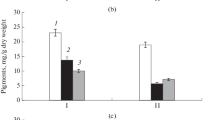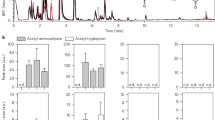Abstract
l-Phosphinothricin (l-Pt)-resistant plants were constructed by introducing a modified phosphinothricin-N-acetyl-transferase gene (pat) via Agrobacterium-mediated gene transfer into tobacco (Nicotiana tabacum L), and via direct gene transfer into carrot (Daucus carota L). The metabolism of l-Pt was studied in these transgenic, Pt-resistant plants, as well as in the untransformed species. The degradation of l-Pt, 14C-labeled specifically at different C-atoms, was analysed by measuring the release of 14CO2 and by separating the labeled degradation products on thin-layer-chromatography plates. In untransformed tobacco and carrot plants, l-Pt was deaminated to form its corresponding oxo acid 4-methylphosphinico-2-oxo-butanoic acid (PPO), which subsequently was decarboxylated to form 3-methylphosphinico-propanoic acid (MPP). This compound was stable in plants. A third metabolite remained unidentified. The l-Pt was rapidly N-acetylated in herbicide-resistant tobacco and carrot plants, indicating that the degradation pathway of l-Pt into PPO and MPP was blocked. The N-acetylated product, l-N-acetyl-Pt remained stable with regard to degradation, but was found to exist in a second modified form. In addition, there was a pH-dependent, reversible change in the mobility of l-N-acetyl-Pt thin-layer during chromatography.
Similar content being viewed by others
Abbreviations
- ac-Pt:
-
N-acetyl-phosphinothricin
- MPE:
-
2-methylphosphinico-ethanoic acid
- MPP:
-
3-methylphosphinicopropanoic acid
- pat :
-
phosphinothricin-N-acetyltransferase gene
- Pat:
-
phosphinothricin-N-acetyltransferase
- pat41:
-
pat gene modified for expression in plants
- PPO:
-
4-methylphosphinico-2-oxobutanoic acid
- Pt:
-
phosphinothricin
References
Arnold, W., Pühler, A. (1988) A family of high-copy-number plasmid vectors with single end-label sites for rapid nucleotide sequencing. Gene 70, 172–178
Bartsch, K., Tebbe, C.C. (1989) Initial steps in the degradation of phosphinothricin (glufosinate) by soil bacteria. Appl. Environ. Microbiol. 55, 711–716
Bartsch, K., Dichmann, R., Schmitt, P., Uhlmann, E., Schulz, A. (1990) Stereospecific production of the herbicide phosphinothricin (glufosinate) by transamination: cloning, characterization, and overexpression of the gene encoding a phosphinothricin-specific transaminase from Escherichia coli. Appl. Environ Microbiol. 56, 7–12
Baulcombe, D.C., Saunders, G.R., Bevan, M.W., Mayo, A.M., Harrison, B.D. (1986) Expression of biologically active viral satellite RNA from the nuclear genome of transformed plants. Nature 321, 446–449
Bayer, E., Gugel, K.H., Hagele, K., Hagenmaier, H., Jessipow, S., König, W.A., Zähner, H. (1972) Stoffwechselprodukte von Mikroorganismen. Phosphinothricin und Phosphinothricyl-Alanyl-Alanin. Helv. Chim. Acta 55, 224–239
Beaucage, S.L., Caruthers, M.H. (1981) Deoxynucleoside phosphoramidites: a new class of key intermediates for deoxypolynucleotide synthesis. Tetrahedron Lett. 22, 1859–1862
Bevan, M.W. (1984) Binary Agrobacterium vectors for plant transformation. Nucleic Acids Res. 12, 8711–8721
Broer, I., Arnold, W., Wohlleben, W., Pühler, A. (1989) The phosphinothricin-N-acetyltransferase gene as a selection marker for plant genetic engeneering. In: Proceedings of the Braunschweig Symposium on Applied Plant Molecular Biology, pp. 240–246, Galling, G., ed. Technische Universität Braunschweig, Braunschweig
Chaleff, R.S., Ray, T.B. (1984) Herbicide-resistant mutants from tobacco cell cultures. Science 223, 1148–1151
Comai, L., Facciotti, D., Hiatt, W.R., Thompson, G., Rose, R.E., Stalker, D.M. (1985) Expression in plants of a mutant aroA gene from Salmonella typhimurium confers tolerance to glyphosate. Nature 317, 741–744
De Block, M., Bottermann, J., Vandewiele, M., Dockx, J., Thoen, C, Gosselé, V., Movva, N.R., Thompson, C., Van Montagu, M., Leemans, J. (1987) Engineering herbicide resistance in plants by expression of a detoxifying enzyme. EMBO J. 6, 2513–2518
Dorn, E., Wink, O., Schwalbe-Fehl, M., Kellner, H.M., Asshauer, J. (1986) Degradation of glufosinate ammonium, ammonium-d, l-homoalanine-4-yl-(methyl)-phosphinate in rats. In: 6th International Congress of Pesticide Chemistry, p.10, IUPAC, Ottawa
Eckhardt, T. (1978) A rapid method for the identification of plasmid deoxyribonucleic acid in bacteria. Plasmid 1, 584–588
Götz, W., Dorn, E., Ebert, E., Leist, K.-H., Kacher, H. (1983) Hoe 39866, a new non-selective herbicide: chemical and toxicological properties — mode of action and metabolism. In: Asian Pacific Weed Sci. Soc., 9. conference, pp. 401–404, Asian Pacific Weed Society, Manila
Haas, P. (1986) Verhalten von Glufosinate-Ammonium in Unkräutern. Doctoral Thesis, Stuttgart-Hohenheim
Hain, T., Przewozny, T., Schieder, O. (1983) Culture and selection of somatic hybrids using an auxotrophic cell line. Theor. Appl. Genet. 64, 119–122
Hoekema, A., Hirsch, P.R., Hooykaas, P.J.J., Schilperoort, R.A. (1983) A binary plant vector strategy based on separation of vir and T-region of the Agrobacterium tumefaciens Ti-plasmid. Nature 303, 179–180
Horsch, R.B., Fry, J.E., Hoffmann, N.L., Eichenholtz, D., Rogers, S.G., Fraley, R.T. (1985) A simple and general method for transforming genes into plants. Science 227, 1229–1231
Langelüdeke, P., Krause, D., Rose, E., Wallmüllder, F., Walther, K.H. (1981) Unkrautbekämpfung mit Hoe 39866 im Obstund Weinbau. Mitt. Biol. Bundesanst. Landund Forstw. 203, 256
Lea, P.J., Joy, K.W., Ramos, J.L., Guerrero, M.G. (1984) The action of the 2-amino-4-(methylphosphinyl)-butanoic acid (phosphinothricin) and its 2-oxo-derivative on the metabolism of cyanobacteria and higher plants. Phytochemistry 23, 1–6
Lütcke, H.A., Clow, K.C., Michel, F.S., Moss, K.A., Kern, H.F., Schule, G.A. (1987) Selection of AUG initiation codons differs in plants and animals. EMBO J. 6, 43–48
Maliga, P., Breznovitz, A., Marton, L. (1973) Streptomycin resistant plants from callus cultures of tobacco. Nature New Biol. 244, 29–30
Maniatis, T., Fritsch, E.F., Sambrook, J. (1982) Molecular cloning. A laboratory manual. Cold Spring Harbor Laboratory Press, New York
Miflin, B.J., Lea, P.J. (1980) Amino acids and derivatives. In: The biochemistry of plants, vol 5, pp. 169–202, Miflin, B.J., ed. Academic Press, New York
Murashige, T., Skoog, F. (1962) A revised medium for rapid growth and bioassays with tobacco tissue cultures. Physiol. Plant. 15, 473–497
Passera, C., Pedrotti, A., Ferrari, G. (1964) Thin-layer chromatography of carboxylic acids and keto acids of biological interest. J. Chromatogr. 14, 289–291
Pipke, R., Amrhein, N., Jacob, G.S., Schaefer, J., Kishore, G.M. (1987) Metabolism of glyphosate in an Arthrobacter sp. GLP-1. Eur. J. Biochem. 165, 267–273
Potrykus, I., Shillito, R.D. (1986) Protoplasts: isolation, culture, plant regeneration. Methods Enzymol. 118, 576–577
Pröls, M., Töpfer, R., Schell, J., Steinbiß, H.H. (1988) Transient gene expression in tobacco protoplasts: I. Time course of CAT appearance. Plant Cell Rep. 7, 221–224
Sauer, H., Wild, A., Rühle, W. (1987) The effect of phosphinothricin (glufosinate) on photosynthesis. II. The causes of inhibition of photosynthesis. Z. Naturforsch. 42c, 270–287
Schulz, A., Taggeselle, P., Tripier, D., Bartsch, K. (1990) Stereospecific production of the herbicide phosphinothricin (glufosinate) by transamination: Isolation and characterization of a phosphinothricin-specific transaminase from Escherichia coli. Appl. Environ. Microbiol. 56, 1–6
Schwerdtle, F., Bieringer, H., Finke, M. (1981) Hoe 039866 — ein neues nicht selektives Blattherbizid. Pflanzenkrankh. Pflanzenschutz 9, 431–440
Shillito, R.D., Paszkowski, J., Potrykus, I. (1983) Agarose plating and a bead type culture technique enable and stimulate development of protoplast-derived colonies in a number of plant species. Plant Cell Rep. 2, 244–247
Simon, R., Priefer, U.B., Pühler, A. (1983) A broad host range mobilization system for in vivo genetic engineering: transposon mutagenesis in gramnegative bacteria. Bio/Technology 1, 784–791
Smith, A.E. (1988) Persistence and transformation of the herbicide [14C]-glufosinate-ammonium in prairie soils under laboratory conditions. J. Agric. Food Chem. 36, 393–397
Strauch, E., Wohlleben, W., Pühler, A. (1988) Cloning of the phosphinothricin-N-acetyl-transferase gene from Streptomyces viridochromogenes Tü 494 and its expression in Streptomyces lividans and Escherichia coli. Gene 63, 65–74
Tachibana, K., Watanabe, T., Seikizawa, Y., Takematsu, T. (1986a) Inhibition of the glutamine synthetase and quantitative changes of free ammino acids in shoots of bialaphos treated Japanese barnyard millet. J. Pest. Sci. 11, 27–31
Tachibana, K., Watanaba, T., Seikizawa, Y., Takematsu, T. (1986b) Accumulation of ammonia in plants treated with bialaphos. J. Pest. Sci. 11, 33–37
Talbot, H.W., Johnson, L.M., Munnecke, D.M. (1984) Glyphosate utilization by Pseudomonas sp. tand Alcaligenes sp. isolated from environmental sources. Curr. Microbiol. 10, 255–260
Tebbe, C.C. (1988) Abbau des Herbizids Phosphinothricin (Glufosinate) im Boden und in Reinkulturen von Bodenmikroorganismen. Doctoral Thesis, Münster
Tebbe, C.C., Reber, H.H. (1988) Utilization of the herbicide phosphinothricin as a nitrogen source by soil bacteria. Appl. Microbiol. Biotechnol. 29, 103–105
Thompson, C.J., Movva, R.N., Tizard, R., Crameri, R., Davies, J.E., Lauwereys, M., Bottermann, J. (1987) Characterization of the herbicide-resistance gene bar from Streptomyces hygroscopicus. EMBO J. 9, 2519–2523
Wild, A., Ziegler, C. (1989) The effect of bialaphos on ammoniumassimilation and photosynthesis. I. Effect on the enzymes of ammonium-assimilation. Z. Naturforsch. 44c, 97–102
Wild, A., Sauer, H., Rühle, W. (1987) The effect of phosphinothricin (glufosinate) on photosynthesis. I. Inhibition of photosynthesis and accumulation of ammonia. Z. Naturforsch. 42c, 263–269
Wohlleben, W., Arnold, W., Broer, L, Hillemann, D., Strauch, E., Pühler, A. (1988) Nucleotide sequence of the phosphinothricin-N-acetyl-transferase gene from Streptomyces viridochromogenes Tü 494 and its expression in Nicotiana tabacum. Gene 70, 25–37
Ziegler, C., Wild, A. (1989) The effect of bialaphos on ammoniumassimilation and photosynthesis. II. Effect on photosynthesis and photorespiration. Z. Naturforsch. 44c, 103–108
Author information
Authors and Affiliations
Additional information
This work was supported in part by a grant from Hoechst AG, Pflanzenschutz, Frankfurt/Main, FRG. The authors wish to thank E. Strauch and W. Arnold (Lehrstuhl f. Genetik, Universität Bielefeld, FRG) for supplying plasmids; R. Eichenlaub (Lehrstuhl f. Mikrobiologie und Gentechnologie, Universität Bielefeld, FRG) for the synthesized oligonucleotides; and I.M. Pretorius-Güth (Lehrstuhl f. Genetik, Universität Bielefeld, FRG) and K. Severin (Lehrstuhl f. Allgemeine Genetik, Universität Tübingen, FRG) for reading the manuscript. W. Droge acknowledges the receipt of a scholarship from DECHEMA, Frankfurt.
Rights and permissions
About this article
Cite this article
Dröge, W., Broer, I. & Pühler, A. Transgenic plants containing the phosphinothricin-N-acetyltransferase gene metabolize the herbicide l-phosphinothricin (glufosinate) differently from untransformed plants. Planta 187, 142–151 (1992). https://doi.org/10.1007/BF00201636
Accepted:
Issue Date:
DOI: https://doi.org/10.1007/BF00201636




